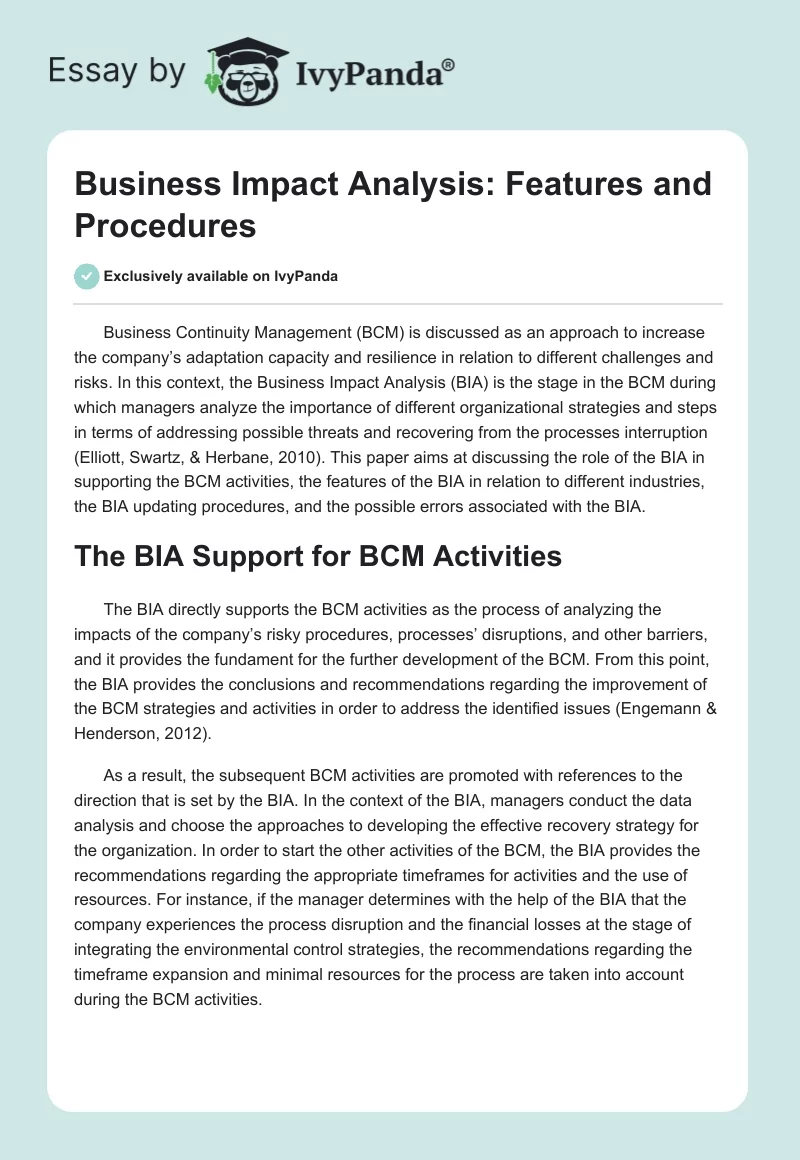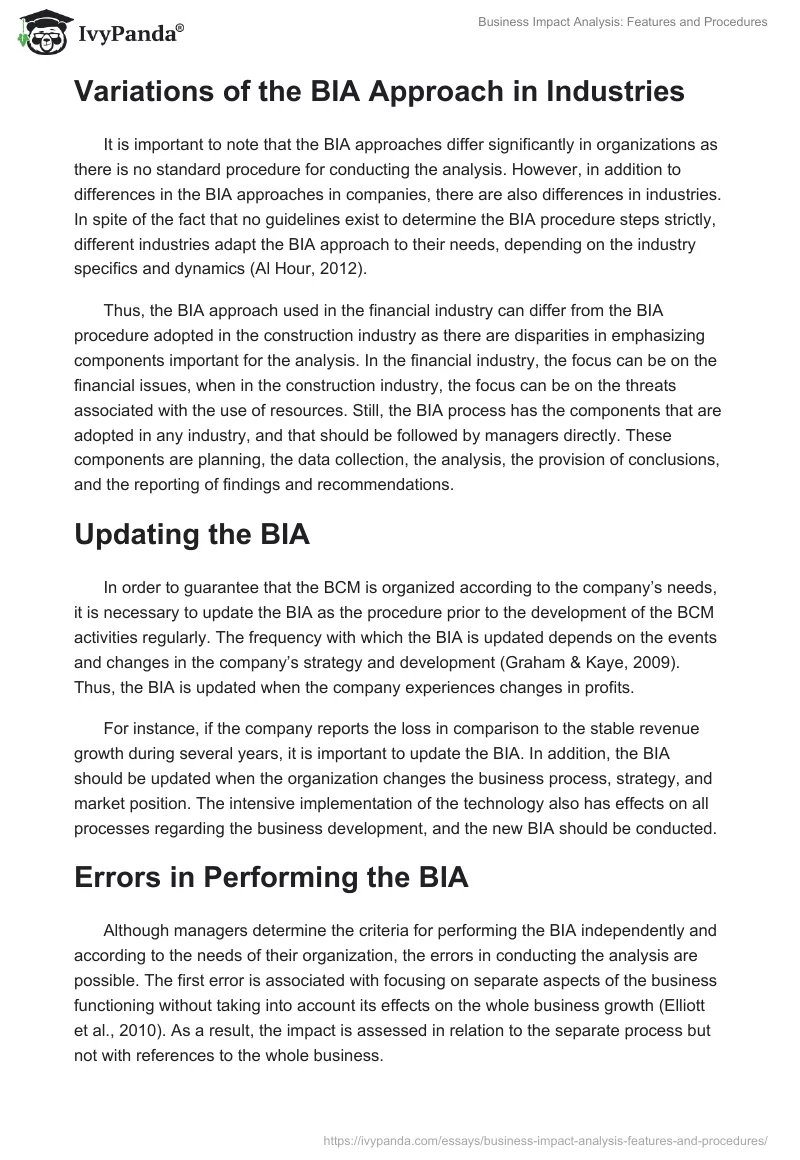Business Continuity Management (BCM) is discussed as an approach to increase the company’s adaptation capacity and resilience in relation to different challenges and risks. In this context, the Business Impact Analysis (BIA) is the stage in the BCM during which managers analyze the importance of different organizational strategies and steps in terms of addressing possible threats and recovering from the processes interruption (Elliott, Swartz, & Herbane, 2010). This paper aims at discussing the role of the BIA in supporting the BCM activities, the features of the BIA in relation to different industries, the BIA updating procedures, and the possible errors associated with the BIA.
The BIA Support for BCM Activities
The BIA directly supports the BCM activities as the process of analyzing the impacts of the company’s risky procedures, processes’ disruptions, and other barriers, and it provides the fundament for the further development of the BCM. From this point, the BIA provides the conclusions and recommendations regarding the improvement of the BCM strategies and activities in order to address the identified issues (Engemann & Henderson, 2012).
As a result, the subsequent BCM activities are promoted with references to the direction that is set by the BIA. In the context of the BIA, managers conduct the data analysis and choose the approaches to developing the effective recovery strategy for the organization. In order to start the other activities of the BCM, the BIA provides the recommendations regarding the appropriate timeframes for activities and the use of resources. For instance, if the manager determines with the help of the BIA that the company experiences the process disruption and the financial losses at the stage of integrating the environmental control strategies, the recommendations regarding the timeframe expansion and minimal resources for the process are taken into account during the BCM activities.
Variations of the BIA Approach in Industries
It is important to note that the BIA approaches differ significantly in organizations as there is no standard procedure for conducting the analysis. However, in addition to differences in the BIA approaches in companies, there are also differences in industries. In spite of the fact that no guidelines exist to determine the BIA procedure steps strictly, different industries adapt the BIA approach to their needs, depending on the industry specifics and dynamics (Al Hour, 2012).
Thus, the BIA approach used in the financial industry can differ from the BIA procedure adopted in the construction industry as there are disparities in emphasizing components important for the analysis. In the financial industry, the focus can be on the financial issues, when in the construction industry, the focus can be on the threats associated with the use of resources. Still, the BIA process has the components that are adopted in any industry, and that should be followed by managers directly. These components are planning, the data collection, the analysis, the provision of conclusions, and the reporting of findings and recommendations.
Updating the BIA
In order to guarantee that the BCM is organized according to the company’s needs, it is necessary to update the BIA as the procedure prior to the development of the BCM activities regularly. The frequency with which the BIA is updated depends on the events and changes in the company’s strategy and development (Graham & Kaye, 2009). Thus, the BIA is updated when the company experiences changes in profits.
For instance, if the company reports the loss in comparison to the stable revenue growth during several years, it is important to update the BIA. In addition, the BIA should be updated when the organization changes the business process, strategy, and market position. The intensive implementation of the technology also has effects on all processes regarding the business development, and the new BIA should be conducted.
Errors in Performing the BIA
Although managers determine the criteria for performing the BIA independently and according to the needs of their organization, the errors in conducting the analysis are possible. The first error is associated with focusing on separate aspects of the business functioning without taking into account its effects on the whole business growth (Elliott et al., 2010). As a result, the impact is assessed in relation to the separate process but not with references to the whole business.
Another error is the focus on the financial impacts of interrupted processes and operations without focusing on the role of the interruption in other activities of the organization. In addition, the errors can occur when the manager approaches the BIA as a traditional risk assessment procedure as there are differences in analyzing the data. For instance, a manager can choose to use the risk assessment instead of the BIA before performing the other BCM activities. In this case, the proposed strategies can be irrelevant and ineffective to overcome the problems.
Conclusion
The BIA plays an important role in the BCM because of providing the foundations for the other processes associated with recovering from the issues and adapting the strategies to possible risks. The BIA should be used by managers regularly, depending on the business development, in order to guarantee positive results in the BCM activities.
References
Al Hour, A. (2012). Business continuity management: Choosing to survive. New York, NY: IT Governance Ltd. Web.
Elliott, D., Swartz, E., & Herbane, B. (2010). Business continuity management: A crisis management approach. New York, NY: Routledge. Web.
Engemann, K. J., & Henderson, D. M. (2012). Business continuity and risk management. Brookfield, CT: Rothstien Association Inc. Web.
Graham, J., & Kaye, D. (2009). A risk management approach to business continuity: Aligning business continuity with corporate governance. Brookfield, CT: Rothstien Association Inc. Web.


